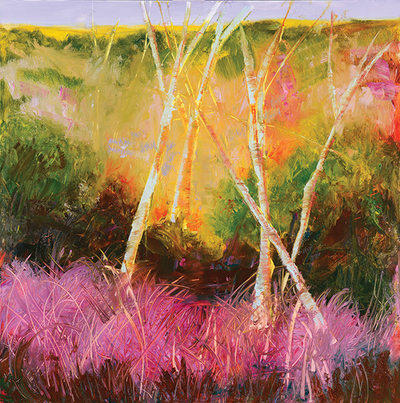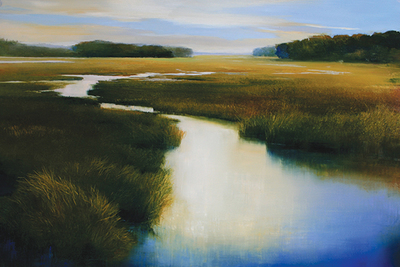Perpetual Transformation

Faye Mylen, Summer Bloom, oil on aluminum, 36 x 36″.
Tracing the aesthetic pathways traveled before them by English landscape artists and French Impressionists, in the late 19th-century a group of respected studio painters and teachers, among them Childe Hassam and Julian Alden Weir, gathered in Cos Cob and Old Lyme, CT, to paint summer’s bucolic meadows, marshes and sheltered rivers springing from Long Island Sound.
Claude Monet, painting in Giverny, kept in touch with the founding American Impressionists of Old Lyme. Like their French compatriots, Connecticut’s Impressionists sought to capture unmediated ways of seeing landscape. A century plus later, this same impetus—the almost physical need to spend countless hours en plein air (outdoors) rendering atmospheric light and shadow reflecting within a meandering stream, perhaps lined with white birch, flowing willows or stubby golden sedge grass, continues to inspire Connecticut landscape painters working within the Impressionist tradition.
Jan Dilenschneider, Faye Mylen and Janine Robertson met through the Silvermine Arts Center in New Canaan, CT, and much like the original Impressionists of Cos Cob and Old Lyme, became friends who paint together. They readily name J. M. W. Turner for his atmospheric essences, Claude Monet for his short brushstrokes barely conveying form and contemporary colorist Wolf Kahn as among their inspirations.
In the process of completing large paintings, including diptychs, or “dualities,” for two exhibitions, Dilenschneider points to a canvas where traces of her hand left purposeful marks on the canvas while forming, or sculpting in oils, the Lieutenant River with its recognizable bend and tree-lined bank. This bucolic location, not far from her Long Island Sound studio, would be recognizable, she says, to the American Impressionists who painted their idealized vistas.

Jan Dilenschneider, Glowing Fields, 2016, oil on canvas, 36 x 36″. Photo: Steve Barnes Photograph Solutions.
Honoring Dilenschneider as an heir to the Connecticut Impressionist tradition, her new work will be exhibited in the fall at the Lyme Academy College of Fine Arts of the University of New Haven.
A colorist whose freely formed scenes and breathing textures are excited by the possibilities of capturing reflection and shadow—“I become the green against purple / I become the green against pink” she wrote for a catalog accompanying one of her exhibitions at the Galerie Pierre-Alain Challier in Paris—Dilenschneider relishes the freedom of squeegees and spatulas alongside very wide brushes as she builds a scene.
She recently exhibited the triptych Flora Against Blue Sky, whose ribbons of vegetation were loosely formed in gamboge yellow, a deep saffron pigment used to dye Buddhist monks’ robes, as the artist’s squeegee pulled back and forth, Expressionist style, across the canvas. These were hung vertically at the Grand Palais on the Avenue des Champs-Élysées, during the 2015 Art Paris Art Fair.
Arms swinging across a canvas, Dilen-schneider illustrates why she considers herself an Expressionist rather than an Impressionist, who would favor small, thin yet still visible brushstrokes. Reveling in bold gestural approaches coming from the arm rather than the wrist, she channels the spontaneity and bravado of a Jackson Pollock or a Franz Kline.
“Art is knowing what to put down—and when to stop. I stop early so I don’t wind up with a staid, totally finished look,” she says, “with little things picked out.” And it’s true—the golden leaves in her trees, painted alla prima, wet into wet, have both texture and lightness, as if tossed by an autumn wind.
Faye Mylen and Janine Robertson both show at the Maple & Main Gallery of Fine Art in the village of Chester, CT, a welcoming two-story space where they participate in year-round group exhibits.

Janine Robertson, Meandering, oil on aluminum, 24 x 36″.
Faye Mylen’s mother was a painter, as was Dilenschneider’s; both artists remember spending hours sitting silently by their mothers’ side, spellbound as a painting emerged. Though her artwork is much in demand, Mylen, youngest of the three profiled, considers herself a “still emerging” painter.
Mylen’s canvases swing between fiery abstraction and minimal Impressionist landscapes, painted en plein air as much as possible and reflecting a very personal vision of her surroundings, texture and line incised to direct the eye into the canvas. “I strive to simplify the views I am painting, bringing in an abstract quality—creating ambiguity while maintaining a sense of depth and space,” she says.
Her Shades of Fall is constructed around a subtle serpentine line from background to foreground. “In painting the Connecticut landscape, I’m trying to find its soul and essence, the feeling of the space, playing with colors to create depth, vibration and ambiance,” she says. “My goal is to capture the spontaneity and vitality you’d feel in nature.”
To push the limits while painting in the studio, she often works from a black-and-white photo. “It allows me to let go of the colors as prescribed by nature, and be free with my choices,” Mylen says. “After all, everything changes when you take the meadow from a lush green to a bright red!”
After a successful career as a muralist and trompe l’oeil painter, Janine Robertson began creating landscape paintings, as a more satisfying, intimate scale within which to work. She often shows with the Lyme Art Association, Connecticut Women Artists, Inc. and the Guild Brook Artists.
Scale and architecture—a strong composition—remain vital elements in her toolbox; gossamer clouds, among the most challenging of forms, are a favorite subject, pulling her outside to study their shadows and volume. A recent commission came from a Florida admirer wanting to see “Connecticut clouds.”
“I’m always chasing the light and glow,” Robertson says, “and the way I think about it is through the Impressionist use of complementary colors. Placed next to each other in a similar tone creates light or luminosity.” An admirer of landscape painter Joshua Reynolds, she considers the appeal of her own landscapes: “People are drawn to my paintings because it gives them a sense of where they’d like to be.” Gazing into paintings like Meandering and Luminous Evening, a viewer becomes immersed in soft streams and a lightly blowing breeze. Robertson will have a solo exhibition at Maple & Main in December 2016.
These three Connecticut Impressionists respect tradition yet upend the “land of steady habits.” Their rendering of regional subject matter transcends the recognizable in reaching for the otherworldly. Watch what emerges as each follows a muse uniquely her own.
Susan Rand Brown is a poet, art critic and frequent contributor to Art New England. She also writes for Provincetown Arts, The Provincetown Banner and the South Florida arts publication Inspicio. She recently developed a multimedia presentation on Provincetown’s formative years as an artists’ colony.
